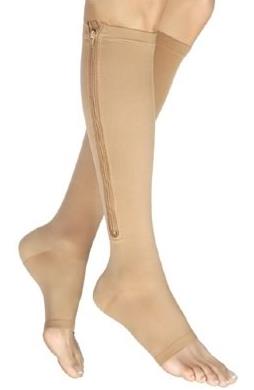If you have weakness and/or arthritic pain in your hands, zipper compression socks or stockings may just be what the doctor ordered to make things easier for you.
Only a limited number of brands such as Jobst, Bell-Horn or Curad (Medline) offer specialized medical compression socks or stockings featuring a zipper to make putting them on and taking them off easier for individuals with restricted strength or dexterity.
Whether you are dealing with swelling or venous issues such as defective valves inside your leg veins or bulging varicose veins, compression therapy is generally the first line of defense in treating these conditions by controlling symptoms and slowing their progression.
Compression on the leg can help resolve problems by restoring proper return blood flow to the heart and lungs and preventing blood and fluid from pooling in the legs. If left untreated, anomalous blood circulation or stagnating blood in the legs can lead to more serious complications such as skin changes, tissue damage or vein and skin ulcerations.
For many wearers of compression hosiery, donning and doffing can be a daily struggle. This is especially true with compression stockings of higher compression classifications (e.g. 30-40 mmHg or higher).
For compression stockings to be most effective, they must be put on first thing in the morning, preferably before getting out of bed. The reason for this is to prevent blood and fluids from surging down into the legs from gravity force and causing the legs to swell before one has a chance to put on their compression stockings. Once the legs have begun to swell it becomes much more difficult to put on compression garments.
How Can Compression Stockings With Zippers Help You?
Zippered compression socks or stockings can make life much easier if you are dealing with any of the following challenges:
- Limited hand and/or arm strength makes it a struggle to put on or take off your compression hosiery
- Arthritis in the hands and/or arms makes donning or doffing compression stockings difficult
- Swelling in the legs makes it difficult to get compression stockings on or off
- Sensitive skin causes problems with putting on compression socks or taking them off
- Venous leg ulcer care makes donning and doffing of compression stockings challenging
Zipper compression stockings are available mainly in knee-high length and compression strength classifications of moderate with 20-30 mmHg and high 30-40 mmHg. As with all compression stockings above 20 mmHg of graduated compression, the above stated compression levels should be prescribed only as well as monitored under the care of a primary physician or a vein specialist.
Compression support leg wear in the 20-30 mmHg range is designed to boost blood circulation and reduce swelling in the legs. Knee-high compression stockings with a built in zipper make it easier for the patient or caregiver to put on the support hosiery or take it off before retiring to bed. The zipper feature on the support stockings also provides quick access during doctor visits for medical examination.
20-30 mmHg Compression Stockings are designed to help with
– Aching, heavy and tired feeling legs
– Milder varicose veins during pregnancy
– Mild to moderate swelling
– Recovery after venous procedures (sclerotherapy, radio frequency ablation, vein surgery)
– Leg swelling as a result of inactivity
 30-40mmHg knee-high compression stockings are mainly prescribed for individuals with more severe venous conditions.
30-40mmHg knee-high compression stockings are mainly prescribed for individuals with more severe venous conditions.
Zippered 30-40 mmHg compression socks are frequently the support garment of choice for wound care patients with venous ulcers, which can make the donning and doffing of compression garments particularly challenging.
Specific for ulcer patients, some zipper compression stocking brands such as Jobst® Ulcer Care and Ames Walker style 62901 are designed as a dual stocking system.
These two part systems consist of a liner sleeve which helps with holding the wound dressing in place and the outer zippered stocking for easier donning and doffing.
30-40 mmHg Compression Stockings are designed to help with
– Chronic venous insufficiency
– Severe varicose veins and edema during pregnancy
– Deep vein thrombosis (if too painful lesser compression may be needed initially)
– Post thrombotic syndrome
– Serious varicose veins
– Severe edema or lymphedema
– Orthostatic hypotension
– Postural hypotension
Zippered anti-embolism stockings with a compression level of 18 mmHg are available from company Bell-Horn in a comprehensive range of knee length and thigh length sizes. These TED hose style stockings are intended for patients suffering from venostasis and those who are immobile after surgery.
In summary, it should be pointed out that the treatment strategies involving compression stockings often fail because of poor participation (compliance) of the patients. For example, elderly patients or overweight patients are often faced with severe difficulties in applying compression stockings. They often must rely on assistance from family members or care personnel for donning and doffing their support stockings.
With the availability of compression stockings with zippers, such patients have a much easier time putting their stockings on or taking them off thereby encouraging them to be fully compliant with their compression therapy.
However, some patients who cannot tolerate the pressure and/or elastic of compression hosiery because of sensitive skin or because they tend to easily develop irritations and sores may not be able to wear zipper type compression stockings.
Fortunately for these individuals there are adjustable compression wraps or bands available such as the CircAid Juxta-Fit compression wrap, which allow the patient to adjust the compression to any level between 20-30, 30-40 or even higher as directed by their physician.
If you liked this post please let us know by clicking the Facebook like button below. We also appreciate any comments and personal experiences you have to contribute.
